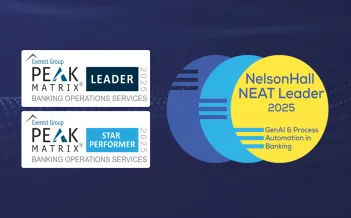When the government introduced the Bounce Back Loan Scheme (BBLS) and the Coronavirus Business Interruption Loan Scheme (CBILS), they created a critical lifeline to many struggling businesses. But for the lenders offering these loans the schemes have unearthed a number of internal administrative problems related to processing and servicing loans at the speed and scale required.
Pre-pandemic, when faced with peaks in demand, banks could increase manpower to support processes such as applications and query handling. But this has become more difficult during lockdown. As a consequence, lenders have struggled to process the high volumes of applicants with the urgency CBILS and BBLS loans required. They are now facing the next big challenge – servicing these customers.
The National Audit Office predicts that for BBLS alone, 35% to 60% of the loans could be defaulted on due to fraud or businesses simply being unable to pay. This puts lenders under enormous pressure to minimise the risk of losses while keeping application and account servicing as smooth as possible. Financial services organisations are using this as an opportunity to review their entire customer service operations and processes to optimise tasks, eliminate wasteful activities e.g. by embracing LEAN methodologies, and boosting efficiency. The back-office has been suddenly thrown into the spotlight and brought to the forefront in this process.
Back office backlog causing delays
Many lenders have grown through mergers and acquisitions, which, along with organic technology development, has translated into a proliferation of legacy technology. With data sitting across multiple disparate applications, operations staff and managers are having to use multiple business apps to process transactions and obtain management information, resulting in more hops and slower processing. This is not a problem if you have time, but BBLS and CBILS account servicing is time-sensitive.
With this backdrop, lenders are putting back-office transformation at the top of their agendas. They are prioritising changes that will eliminate friction in processes, maximise productivity, enable quicker, data-driven decisions, and increase straight-through processing by:
- Optimising business processes by removing non-value tasks and wasteful activities
- Automating manual tasks within those processes
- Optimising customer communications
Let’s dig into these in more detail.
Optimising business processes
Leveraging time-testEdTechniques like LEAN, organisations can remove waste and low/non-value tasks from business processes, and streamline operations. It is important to challenge the status-quo and assertively question the value of each and every task in the process. This simplifies and optimises processes by removing tasks that add no clear value to the operation. Likewise, process standardisation allows lenders to ensure that all operators follow the same processes increasing predictability of outcomes and reducing training time. Techniques such as “5 why’s” and “value stream mapping” can be particularly useful to identify interventions.
Automating manual processes
Lenders, wanting to strengthen data processing capabilities are turning to Artificial Intelligence (AI) and Intelligent Automation (IA) to automate hundreds of manual backend processes. Automation can speed up risk identification by using trained systems to detect red flags on loan accounts. One commercial finance division of a leading UK bank recently began using intelligent automation provided by Firstsource to streamline invoice processing. Using automation in this way enabled the lender to save £3.5 million per year in risk exposure. This approach can also save time on manual processes, which means people can be redirected to support sensitive customer interactions.
Likewise, robotic automation (RPA) can dramatically reduce the complexities of dealing with multiple, disparate back office applications. Using RPA, organisations can create clean, simplified, user-centric interfaces. This removes the need for operators to be trained on different interfaces allowing them to seamlessly navigate various business applications to process transactions and customer enquiries. A single user screen can be used to process transactions whilst the bot deals with the complexities of logging-in and navigating the various screens in the backend applications. The bot pulls together all the data required for a given transaction into the single screen, and any changes made by the operator to either the customer record, or the transaction, are processed in the backend systems by the bot.
Optimising customer communications
It is important that organisations factor in changing customer profiles and preferences from CBILS and BBLS applicants. Servicing strategies need to consider new communications channels in order to sustain strong customer relationships. This is why lenders are increasingly looking to optimise communications by using data and digital channels.
Customers’ contact preferences can be identified by running analytics on profile data such as age, demographic and contact history. The insights gained can be used to devise more strategic contact approaches. Using AI to analyse historic contact patterns can also help forecast customer call and chat volumes, enabling lenders to resource appropriately and meet demand variability.
Importantly, digital communications offer less intrusive contact options than traditional voice calls. This is welcomed by customers who are not ready for personal financial discussion. Web-portals, emails and texts, can give customers easy access to relevant information – reducing non-essential contact for service agents, freeing up time for more meaningful conversations.
Harnessing empathy, insights, and agility
Customers who have taken out coronavirus business loans will continue dealing with stress and pressure; account servicing doesn’t need to be part of this. Lenders can support customers by focussing on efficient account servicing – this is where an approach rooted in empathy, insight and agility becomes essential. By transforming the back-office to mitigate inefficiencies, lenders can optimise their systems and processes, while improving customer communications and ultimately strengthening these relationships.
This article is written by Luis Huerta, Vice President and Intelligent Automation Practice Head, Europe at Firstsource and was originally published in Fintech Finance.










